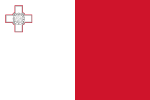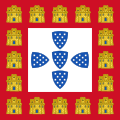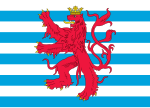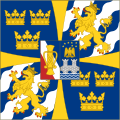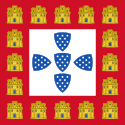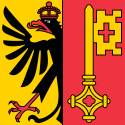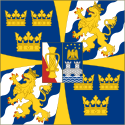Wappenbanner

In der Flaggenkunde wird als Wappenbanner (englisch Banner of the arms, Heraldic banner; Abkürzung BoA)[1] ein meist quadratisches Tuch (später auch rechteckig) mit einem Wappenbild bezeichnet, also die rechteckige Darstellung eines Wappens auf einem Tuch.[2]
Entwicklung
Wappenbanner sind eine der ursprünglichsten Formen von Flaggen. Erstmals wurden sie durch Adlige im Mittelalter verwendet. Daraus entstanden zum Beispiel die ersten Nationalflaggen Portugals und Spaniens. Heute finden sich Wappenbanner als Göschs bei verschiedenen Seestreitkräften, den Fahnen der Schweizer Kantone, Gemeindeflaggen und Amtsflaggen von Staats- und Regierungschefs. Nur fünf Nationalflaggen kann man heute noch als Wappenbanner bezeichnen: Jene der Schweiz, von Kiribati, Malta, des Kosovo und von Namibia. Ein Beispiel aus Deutschland ist die Flagge von Hamburg.
Galerie
 Nationalflagge Kiribatis
Nationalflagge KiribatisNationalflagge des Kosovo
 Nationalflagge Maltas
Nationalflagge Maltas Fahne der Schweiz
Fahne der Schweiz Nationalflagge Namibias
Nationalflagge Namibias


 Flagge Portugals unter Alfons III., 1248 bis 1385
Flagge Portugals unter Alfons III., 1248 bis 1385 Luft- und Schifffahrtsflagge Luxemburgs: „De Roude Léiw“ (Der Rote Löwe)
Luft- und Schifffahrtsflagge Luxemburgs: „De Roude Léiw“ (Der Rote Löwe)Flagge des Schweizer Kantons Genf
 Flagge der Krone von Kastilien und Léon
Flagge der Krone von Kastilien und Léon
Siehe auch
Einzelnachweise
- ↑ Flags of the World - Frequently Asked Questions - Part 1.
- ↑ Bundesverwaltung, Bevölkerungsschutz der Schweizerischen Eidgenossenschaft: Vexillologie (Fahnen II) - Fachbegriffe (PDF; 925 kB)
Weblinks
Auf dieser Seite verwendete Medien
Schweizerfahne, Flagge der Schweiz. Commons-Seite zur Schweiz → Confoederatio Helvetica.
Flagge Namibias
Autor/Urheber: Philip Allfrey, Lizenz: CC BY-SA 2.5
Banners of Knights of the Thistle, hanging in St Giles Cathedral in Edinburgh.
Autor/Urheber: Nuno Tavares, Lizenz: CC BY-SA 4.0
Flag of Portugal 1248 - 1385
Presidential Flag of Ireland with alternate official state harp design
This symbol means that the flag in question is no longer used. (historical flag)
Vexillological symbol according to FIAV / Whitney Smith. This symbol means that the flag was reconstructed based on historical documents, but the actual flag may be disputed by historians.
Autor/Urheber: Tijmen Stam (User:IIVQ), Lizenz: CC BY 2.5
Vexillological Symbol according to FIAV / W. Smith
Autor/Urheber: Sodacan, Lizenz: CC BY-SA 4.0
Personal command-sign of the King of Sweden
Standard of the Crown of Castile


